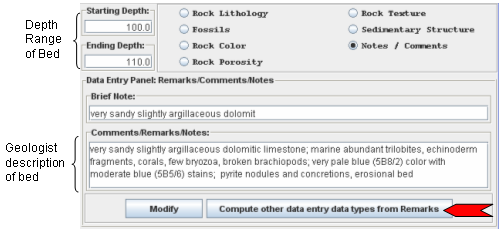

|
HELP: Remarks - Parse Rock Color from Text |
 |
The best way to enter the other rock image data is to enter your
description of the bed in the Remarks / Notes / Comments Data Entry
Dialog and build a list of bed descriptions and then select the "
Compute other data entry data types from Remarks" button. This will allow the program to automatically use the geological description lookup xml files to parse your text into the rock image tracks. This basically saves time and effort, instead of entering each track separately. |
| A Texture / Lithology example
"very sandy slightly argillaceous dolomitic limestone; marine
abundant trilobites, echinoderm fragments, corals, few bryozoa, broken
brachiopods; very pale blue (5B8/2) color with moderate blue (5B5/6)
stains; pyrite nodules and concretions, erosional bed".
The phrase "very pale blue (5B8/2) color with moderate blue (5B5/6)
stains" will be parsed into the primary and secondary colors respectively.
very pale blue (5B8/2) is the main rock color, moderate blue (5B5/6) is
the secondary color.
The parse engine will look for up to 3 colors to display from 3 color list xml lookup files, which are
The color name is very similar to the texture in that there are a number of levels a primary color and modifiers to the primary color, i.e. "very pale blue", "blue" is the primary color and "very pale" is the modifier. NOTE: Sometimes geologies will use a single color, i.e. "blue", which by itself will not produce anything, so "moderate" is automatically assumed and combined with the color name if no other valid modifiers exist, so "blue becomes "moderate blue". NBS/ISCC Color System3 has defined a Universal Language of Color web page that explains the naming convention of colors. To convert the Munsell Color Code to RGB values a file all.dat was downloaded from the Munsell Color Science Laboratory4. The description of this file was as follows,
These are all the Munsell data, including the extrapolated colors.
Note that extrapolated colors are in some cases unreal. That is, some
lie outsize the Macadam limits. |
|
References:
(1)
NBS/ISCC Color System Centroids
Copyright 2003 Voluntocracy http://tx4.us/nbs-iscc.htm
(2)
Spectrophotometric and Colorimetric Determination of the Colors of the
TCCA Standard Color Cards GENEVIEVE REIMANN, DEANE B. JUDD, and
HARRY J. KEEGAN JOSA, Vol. 36, Issue 3, pp. 128-159 (1946)
(3)
The NBS/ISCC Color System - The Universal Language of Color
http://www.anthus.com/Colors/NBS.html
(4)
Munsell Color Science Laboratory http://www.cis.rit.edu/mcsl/online/munsell.php
Author: John R. Victorine jvictor@kgs.ku.edu